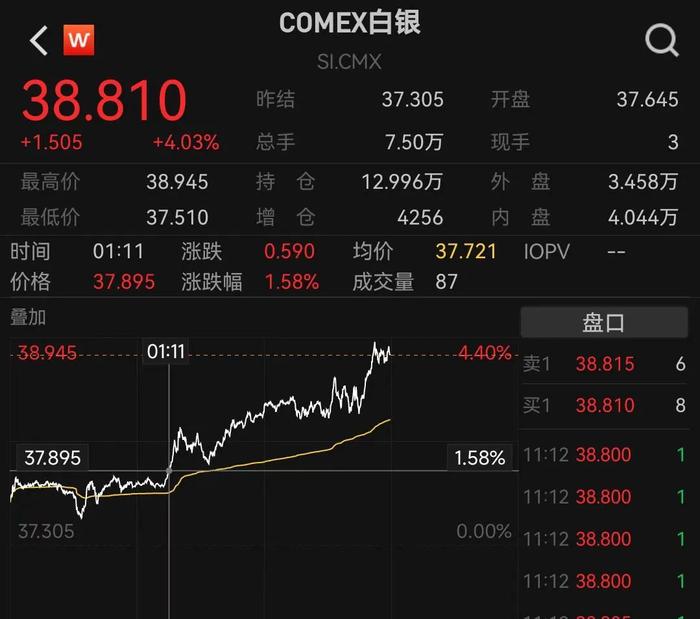


On July 11th, after the opening of U.S. stocks, they all fell back, and as of this writing,
The Dow Jones Industrial Average fell by 0.71%, the Nasdaq Composite dropped by 0.21%, and the S&P 500 Index declined by 0.41%.
In terms of individual stocks, most cryptocurrency-related stocks saw an increase in value, with Bit Origin soaring over 40%. Notably, cryptocurrencies such as Bitcoin continued to rise, with Bitcoin surging over 6.5% as of this writing. According to Coinglass, nearly 28,000 people have been liquidated in the past 24 hours due to cryptocurrencies. Additionally, Nvidia rose by more than 1% on Friday, reaching a new historical high during trading.
At the same time, European stock markets experienced a downturn, with both the Euro Stoxx 600 Index and the Euro Stoxx 50 Index plummeting by more than 1%. Analysts say that investors’ concerns about the uncertainty of U.S. tariff policies have resurfaced, leading to a rise in market risk aversion.
Furthermore, there were bearish signals for Europe’s economy. According to the latest data released by the UK’s Office for National Statistics, the UK economy unexpectedly contracted by 0.1% in May, marking its second consecutive month of decline. As a result, the exchange rate of the British pound against the dollar significantly decreased, closing at 1.3487 at 22:20 Beijing time, a drop of 0.7%.
Precious metals surged, with gold and silver prices rising significantly. By the time of publication, spot gold had increased by more than 1%, reaching above $3,364 per ounce.
Spot silver also rose by more than 4%, surpassing $38 per ounce, setting a new high since September 2011.
WTI crude oil futures advanced by 2.4%, closing at $68.1 per barrel. Brent crude futures reached $70 per barrel, with the latest price at $70.022, up by 2.01% on the day.
The market’s risk points remain President Trump’s so-called “reciprocal tariffs.”
According to news reports, on July 10th local time, it was learned that U.S. President Donald Trump stated in a telephone interview with American media that he plans to impose a unified tariff of either 15% or 20% on almost all trade partners who have not yet been subject to tariffs.
Trump said, “We will impose tariffs on all remaining countries, whether at 15% or 20%, and we are currently arranging this.”
Additionally, on the same day, Trump announced that starting from August 1st, tariffs would be imposed on goods imported from Canada at a rate of 35%.
Recently, Trump sent letters to leaders of over 20 countries including Japan, South Korea, and Brazil, stating that new tariffs would be imposed on these countries starting from August 1st.
The minutes of the Federal Reserve’s monetary policy meeting released on Thursday confirmed the internal disagreement within the Fed regarding inflation and interest rate cuts. The minutes revealed that the divergence among Fed officials on the outlook for interest rates mainly stemmed from differing expectations about the impact of U.S. tariff policies on inflation.
Subsequently, various Fed officials expressed different opinions on interest rate cuts, which also left investors confused. Fed Board member Christopher Waller reiterated on Thursday that he believes the Fed might consider cutting interest rates later this month, as inflation caused by tariffs is temporary.
“I think our policy is too tight; we could consider lowering the policy rate in July,” Waller said. He added, “This has nothing to do with politics.”
These views align with Trump’s position. Trump has repeatedly called for the Fed and Jerome Powell to ease monetary policy, arguing that tariffs have not yet led to inflation and that if the United States can reduce its debt interest payments, it will save a significant amount of money.
However, at the same time, more Fed officials hope for more data and time to observe the impact of tariffs on inflation.
The Governor of the St. Louis Federal Reserve Bank, Alberto Mussalegma, stated that he has yet to determine whether the inflation triggered by tariffs is a one-time shock or will persist for an extended period. He noted, “It will take time to observe the impact of tariffs before we can determine the actual changes in the prices people are actually paying.” Many colleagues hold this cautious view.
Mary Daly, the Governor of the San Francisco Federal Reserve Bank, is slightly more lenient but not as aggressive as Waller. She still believes there could be two rate cuts this year and hinted that the September meeting would be the next window of opportunity.